Native Narratives: Native Authors on Recent Gains in Children’s Publishing
Cynthia Leitich Smith, Joseph Bruchac, Carole Lindstrom, and more share how the market for children’s books by Indigenous authors has changed for the better.
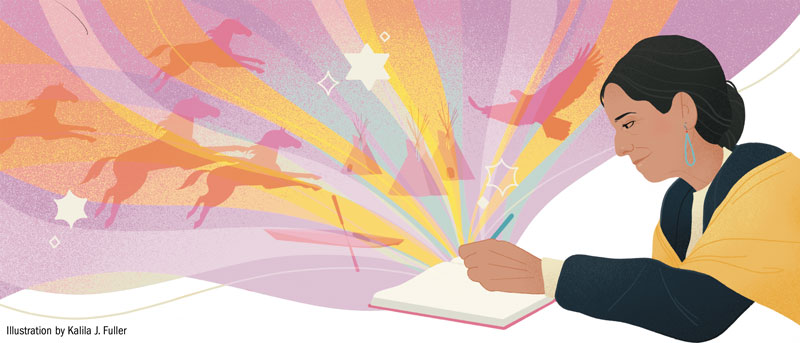
As a child, Cynthia Leitich Smith spent every Saturday at the public library in her Kansas City neighborhood. She would leave with stacks of books, but none of them reflected her culture.
“I don’t recall reading a book by a Native author until I was in college or law school,” says Smith, who today is an author with and the curator of Heartdrum, a Native imprint of HarperCollins Children’s Books. “When I was growing up, there was Native content, but not Native-authored content.”
During Smith’s childhood in the 1970s and 1980s, that wasn’t unusual. Children’s books by Indigenous creators were hard to find, and books about Native people by white authors were often filled with stereotypes and factual inaccuracies.
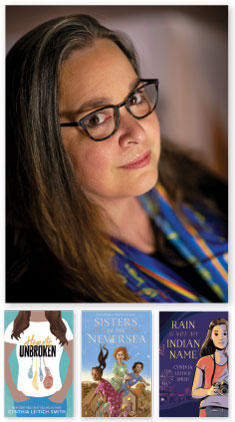 |
Cynthia Leitich SmithPhoto by Christopher T. Assaf |
“I would go out of my way to avoid picking up any title that had Native-coded cover art or other marketing information,” says Smith, who’s a citizen of the Muscogee Nation. “At an early age, something had told me that books that presented a distorted reflection of us were not for us.”
Part of Smith’s work with Heartdrum, which launched in January of 2021, is to find Native authors and illustrators and support them in preparing their work for publication.
Statistics from the Cooperative Children’s Book Center show that Native people are one of the least represented groups in children’s literature, but that representation is increasing. In the last five years, several Native children’s writers, such as Carole Lindstrom, Angeline Boulley, and Kevin Noble Maillard, have risen to prominence.
Their success is encouraging to more established writers like Smith who started publishing when the industry wasn’t as open to Native voices.
“What I was told was, ‘We don’t need your voice. We already have Joseph Bruchac. We don’t need your voice. We already have Sherman Alexie.’”
Smith, who went on to write Jingle Dancer and Rain Is Not My Indian Name, says even her friends in the industry were discouraging.
“When I first started as a children’s author, a dear friend [who] was genuinely trying to help me understand how our world works said, ‘You know your Native books are for white kids, and they’re to teach them about Indian kids and cultures,’ which was just stunning to me,” says Smith. “But for a long time, that was the approach. The books were seen as social studies and not literature, not necessarily books you would give to inspire or entertain, but books you would give to inform, and they very much centered a non-Native, specifically white, gaze.”
That’s something she’s working to avoid with Heartdrum. Books published under this imprint feature character-driven narratives set in the present or the near past.
Smith also has a popular blog called “Cynsations,” which shines a light on authors from marginalized backgrounds and provides information to help new ones navigate the publishing industry.
 |
From the Left: Cynthia Leitich and Traci Sorell holding each other’s picture books at a Kansas-Missouri SCBWI Conference; Sorell during a visit to the Cherokee Nation Immersion School where she presented to a third grade class that surprised her by reading We Are Still Here! Native American Truths Everyone Should Know (Charlesbridge, 2021), prior to her arrival; Native American children’s books on display at Books & Burrow, an Indigenous-owned bookstore in Pittsburg, KS.Class photo by Carolyn Swepston; Display photo by Traci Sorell |
Several Native authors credit Smith with blazing a trail for them. When Dawn Quigley was trying to get her writing career off the ground, she reached out to Smith for advice after receiving several rejections from publishers for what would become her debut novel, Apple in the Middle.
Quigley, who’s a citizen of the Turtle Mountain Band of Ojibwe, says Smith praised the manuscript and encouraged her to keep going. Now, Quigley is publishing her “Jo Jo Makoons” chapter book series with Heartdrum.
“I ended up meeting somebody who is a foster parent of an Ojibwe girl, and they were reading Jo Jo Makoons. This little girl looked up to her foster mom and said, ‘Ah, she,’ she pointed to the character of the book, ‘She’s Ojibwe,’ and then she pointed to herself. She said, ‘I’m Ojibwe.’ And I just thought, my books aren’t on any bestseller list, but when I hear that, that’s just amazing.”
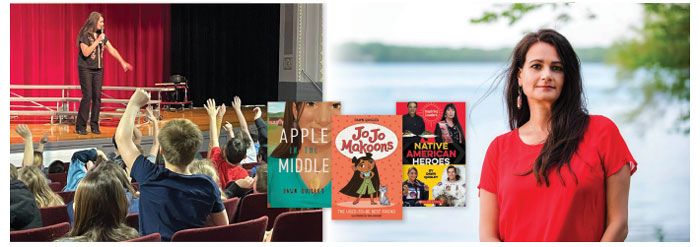 |
From the Left: Dawn Quigley talks about being an Ojibwe author to K-6 students.The MN district’s Indian Education program sponsored the visit.Photos courtesy of Dawn Quigley |
Quigley, who has a doctorate in culture and teaching, spent 18 years in K–12 classrooms before pursuing writing as a career. Now she teaches at the university level. She credits high school students she advised through an Indian Education program in her district with pushing her to write.
“They would come, and they were frustrated because of the things their teachers were saying, like [how] the Indian boarding schools weren’t that bad. Or reading, just really poor, biased, [and] racist representation of Native people in the curriculum,” says Quigley.
Later on, she says a voice in her head told her that she needed to tell these students the stories of their people, and she slowly started writing her first novel.
“I wrote it because I wanted a positive representation,” says Quigley, who also acknowledges the tragic parts of Native history. “It’s really important that all students, and especially educators, read that. But if they only read that, there’s this one narrative: It’s the tragic Native people in the past, and I really wanted to write against that.”
Carole Lindstrom, who is a citizen of the Turtle Mountain Band of Ojibwe, shares Quigley’s goals about publishing positive representations of Native people for young readers.
Like many Indigenous people of her generation, Lindstrom didn’t grow up reading Native authors. The We Are Water Protectors author spent her childhood in Bellevue, a suburb of Omaha, NE, during the 1960s and 1970s, and many of the books that were available to her were not affirming.
“I read the ‘Little House on the Prairie’ series, and boy, it really was hard on me,” says Lindstrom. “I loved the [idea of] family and how they got along, because sometimes my family life wasn’t so good. But anytime they brought up Native peoples, we were ‘savages’ and ‘wild’ and ‘bad,’ so of course, I saw myself that way. I struggled a lot with [those] books, and now as an adult, I see why.”
 |
From the Left: Carole Lindstrom wearing a traditional ribbon skirt posing with Turtle Mountain Tribal Chairman Jamie Azure (center) and other members of the Tribal Council at the National Mall in Washington, DC.; Lindstrom with Michaela Goade, illustrator of We Are Water Protectors (Roaring Brook, 2020).Photos courtesy of Carole Lindstrom |
Lindstrom didn’t start writing until 2007, when her son was born. Through reading him to sleep every night, she discovered a passion for children’s storytelling, and buying him so many books caused her to take a critical look at the publishing industry.
“I started to see the lack of diversity and a lack of stories about Native peoples that are just more about who we are and what we do as vibrant parts of the community,” says Lindstrom, who began to think she could write some of the missing stories about Indigenous people.
At the time, she was working in architectural lighting and writing in her spare time. But when she started talking to people in publishing, she was discouraged by what she heard.
“I would go to conferences, and I was told that nobody wants your stories, nobody wants these books,” says Lindstrom.
But others encouraged her to keep at it, and in 2013, she published her first book, Girls Dance, Boys Fiddle, with Pemmican Publications, a small Canadian press that specializes in publishing Indigenous authors.
In 2017 she got an agent, and shortly thereafter sold We Are Water Protectors, illustrated by Michaela Goade, to Macmillan. The book published in 2020 and won the Caldecott Medal in 2021.
Lindstrom strives to create books that will inspire Indigenous youth today. She wants them to be proud of their heritage and not experience what she did as the only Native child growing up in her community.
“I was ashamed of who I was, and my mother didn’t really know who we were,” says Lindstrom, who’s the daughter of a Native woman and a Swedish American man. “My grandmother was forced into Indian boarding schools, and so all of our past and all of our culture and all of who we are was really erased.”
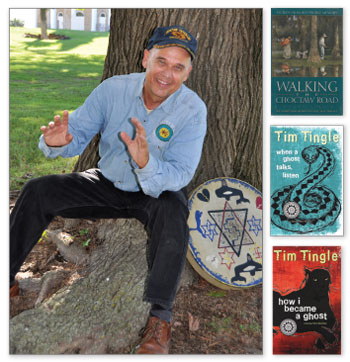 |
Tim TinglePhoto by Lisa Reed |
That erasure drives many Native writers to tell their stories. Award-winning author Tim Tingle is a member of the Oklahoma Choctaw Nation. But as a child his grandmother, who was born in the 1890s, was adamant that he did not tell anyone their family was Choctaw.
“We were forbidden from telling anyone that we were Indian, because she feared the same thing could happen to us that had happened to her,” says Tingle. “She had been kidnapped from her family at the age of 12, sold to an Indian boarding school, and never saw her family again. Ever.”
Tingle says it was only shortly before his grandmother died that she gave him and the rest of his family permission to tell their stories.
“She said it’s time for us to be proud of who we are, and that really was the number one inspiration for my writing,” says Tingle, who was a junior in college at the time.
Tingle began telling his stories. Eventually, telling Choctaw stories became his full-time job. He traveled the world sharing them with people, not thinking about being published until a question about who his favorite storytellers were pushed him in a new direction.
He answered Mark Twain, Herman Melville, and Edgar Allan Poe, but the questioner challenged him that those men were writers, not storytellers.
“I started contemplating the difference, and I thought, well, if a storyteller wants to have his stories last beyond his life, then he should write them down,” says Tingle.
From then on, he started writing down his stories, something he had never done before, expanding them in some cases and creating new characters.
A chance meeting with award-winning author Geary Hobson, a Native scholar who was working at the University of Oklahoma at the time, led to him receiving a full fellowship to attend the university for graduate school.
Through working with Hobson, he was able to publish his first book, Walking the Choctaw Road, shortly after graduating with his master’s degree. That book would go on to be named book of the year in Oklahoma and Alaska in 2005. His first children’s book, Saltypie, was about his grandmother and what happened to her as a girl.
Tingle says he gets several emails a week from Choctaw kids who thank him for writing about the things their parents and grandparents have told them their families endured.
“I think fiction in many ways will open the mind in a way that nonfiction will not, because when people read fiction they move into that world, and that world expands and becomes their own world,” says Tingle. “So, when people are really diving into and really reading a book, they become almost like a character in the book that’s overseeing everything, and they respond emotionally to it. I think books that Native writers are creating have an enormous impact on how people see Native people and see the reality of what we have survived.”
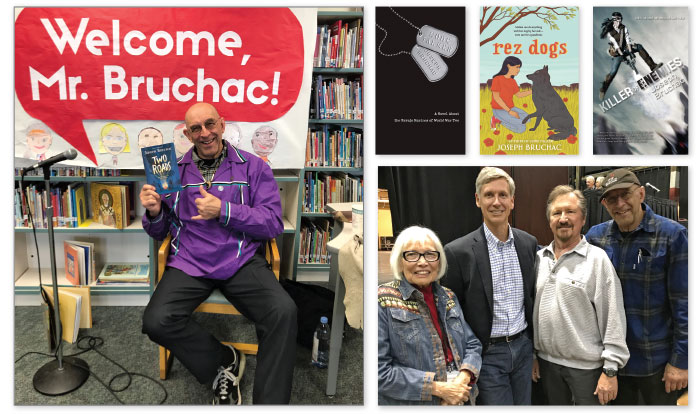 |
From the Left: Joseph Bruchac with Two Roads (Dial, 2018) at a school author visit; Bruchac (at right) with Lakota authors Virginia Driving Hawk Sneve, Philip J. Deloria, and S.D. Nelson.Photos courtesy of Joseph Bruchac |
Joseph Bruchac has been publishing books about Native people for more than 40 years. He’s a member of the Nulhegan Abenaki Nation and was raised by his grandparents on the edge of Saratoga Springs, NY.
Bruchac, who has a doctorate degree in comparative literature, started writing poetry when he was in grade school. His first book of poetry was published in 1971. Today, he’s published nearly 180 books. A small percentage of those are poetry books, but the bulk of them are books for young people.
His children’s books sprang from his desire to tell his children about their ancestry.
“I really wanted my kids to understand more of the traditional culture and the things that were important to me,” says Bruchac. “Often things I had not heard when I was a child, when denial or hiding Native heritage was very common in many of our communities. So I began telling them traditional stories.”
In 1974, he published Turkey Brother and Other Tales: Iroquois Folk Stories, and he’s showing no signs of slowing down. This past summer he published Rez Dogs, a middle grade novel about a girl who spent COVID-19 lockdown on her grandparents’ Wabanaki reservation.
As a Native writer working in the very white world of publishing, there were times when he was misunderstood. He recalls once he wrote about snagging, which is a Native term for trying to pick someone up romantically, and his editor thought he had misspelled snogging, a term for making out in British English.
“Having real Native voices means you’ll get an authentic Native conversation, a Native dialogue, and an understanding of the culture that might not be there if it were written by an outsider,” says Bruchac.
In response to a lack of Native perspectives in publishing, Bruchac and his wife started Greenfield Review, a literary magazine. They would later publish anthologies and other books, including the first book of poetry by Leslie Marmon Silko. Today, Bruchac and his son, Jesse, edit for an imprint called Baldwin Books, which focuses on Native voices from the northeast.
For Bruchac, this work is about continuing to speak out and encourage other Native writers to share their truth.
He says being outspoken as a Native person is difficult due to threats of violence and mistreatment that shadowed Indigenous people throughout his lifetime, including things like boarding schools and a eugenics program in Vermont that forced sterilization on Native people and included the removal of Native children from their families for adoption by white families, a policy that Bruchac says continued in some states through the 1990s. Vermont only formally apologized for these practices in 2021.
This persecution led many Indigenous people to take on new cultural identities. For example, Bruchac says his grandfather and many other Native people in the area identified as French Canadian.
Bruchac says a dear friend of his, who was an Abenaki Nation storyteller, shared with him a story about a family member who was in distress because of the friend’s work.
“In 1982, he called me up to tell me what had happened,” says Bruchac. “He had just begun doing traditional stories publicly, and he had gotten a phone call from his aunt, and his aunt was in a panic. She said, ‘What are you doing? Now, they will know we are here, and they’ll come and get us.’”
As more Native writers find success, the hope is that all young readers will be enriched by their stories, and mainstream publishers will continue to seek out these voices and give them a platform.
“I believe that the existence of [Heartdrum] and the fact that it’s been successful, the books have received a lot of positive critical attention, and they’re connecting well in the marketplace sends a signal to other publishers that this is an area that they may have discounted that they should revisit—or not even revisit, visit for the first time,” says Smith. “Plus, once there are books out there, and kids are reading them and enjoying them, it creates a demand for more.”
|
From the Left: We Need Diverse Books Native Children’s & YA Writing Intensive at the Writing Barn in Austin;
|
Marva Hinton hosts the ReadMore podcast.
RELATED
The job outlook in 2030: Librarians will be in demand
The job outlook in 2030: Librarians will be in demand
ALREADY A SUBSCRIBER? LOG IN
We are currently offering this content for free. Sign up now to activate your personal profile, where you can save articles for future viewing

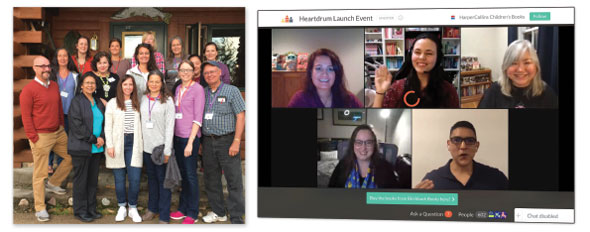




Add Comment :-
Be the first reader to comment.
Comment Policy:
Comment should not be empty !!!